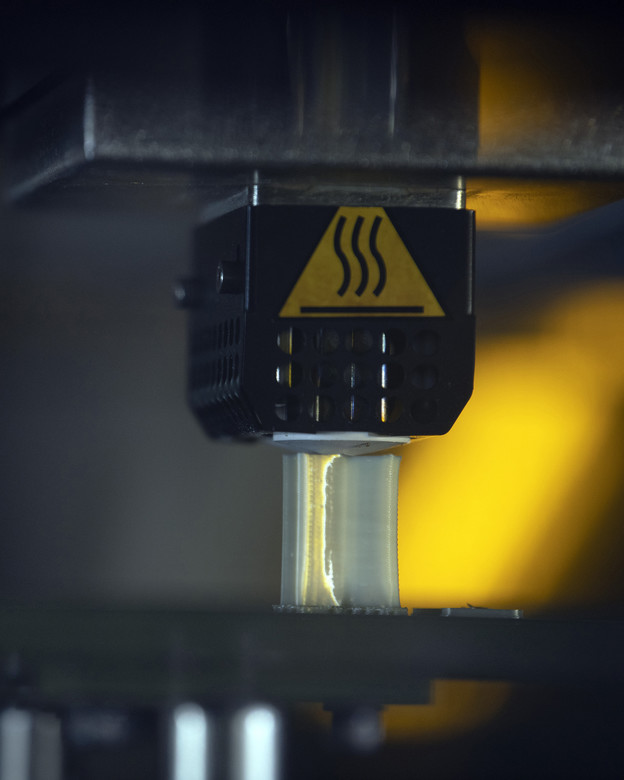The United States Air Force has certified a Stratasys F900 3D printer for use in the 60th Maintenance Squadron at Travis Air Force Base (Travis AFB) in California. It is the first field-unit location in the Air Force to have a certified industrial-sized 3D printer, which is now authorized to produce nonstructural and replacement aircraft parts.
The Stratasys F900 was certified by the Federal Aviation Administration (FAA) and local Air Force Advanced Technology and Training Center due to the advantages of the technology. Using Ultem 9085, the 60th Maintenance Squadron will apply the 3D printer to save cost and time when finding effective solutions for producing critical parts.
“It brings us a capability that we’ve never had before,” said Master Sgt. John Higgs, 60th MXS aircraft metals technology section chief.
“There’s so many possibilities available to us right now. We’re just scratching the surface.”

The Stratasys F900 and Ultem 9085
The F900 3D printer was unveiled by Stratasys at RAPID+TCT 2018 in three variants: the F900, the F900 AICS (Aircraft Interiors Certification Solution), and the F900 PRO. It represents the third generation of Stratasys’ flagship series of FDM 3D printers. The systems feature an MTConnect-ready interface with end-use product level accuracy and repeatability, and have been used in industries such as aerospace, automotive and railway. With a build size of 36 x 24 x 36 inches, the F900 was identified for Travis AFB’s operations because of its ability to produce large plastic parts.
Ultem 9085 is an engineering-grade thermoplastic that has been previously standardized for use in Airbus A350 XWB. A relative of high-performance PEEK and PEKK, the material has a unique strength-to-weight ratio, alongside flame resistant properties that have been classified for aerospace. Ultem 9085 presents a flexible, dense and stronger alternative to plastic for the 60th Maintenance Squadron.
Certified Stratasys 3D printer saves time at Travis Air Force Base
Installing the system at Travis AFB took a total of eight months, due to stringent requirements and necessary training. The first approved project for the Stratasys F900 was 3D printed on August 12. The parts made in this initiative will be used as replacements to the latrine covers aboard the C-5M Super Galaxy aircraft. Often, parts that are not integral to aircraft mission objectives do not have a high priority for replacement. This means that when these parts need to be replaced, like the latrine covers, it will typically take a while until the Air Force unit receives them. Using 3D printing, the unit can produce the parts themselves without having to wait. “The latrine covers we just printed usually take about a year from the time they’ve been ordered to the time they’ve been delivered,” added Higgs. “We printed two of the covers in 73 hours.”
Air Force technicians source models for 3D printing from a University of Dayton Research Institute (UDRI)-approved online database. Three members of the 60th Maintenance Squadron were selected as the first technicians in the Air Force trained to use the certified Stratasys F9000. One of them, Tech. Sgt. Rogelio Lopez, 60th MXS assistant aircraft metals technology section chief, has been on-board the project since it began. Excited by the willingness of the Air Force to implement new technology at the field level, Lopez said, “The Air Force continues to encourage Airmen to be innovative by finding new ways to streamline processes and save resources.”
Travis AFB has already begun receiving requests from other bases in the Air Force to 3D print parts and backfill supplies, so that they can replace their items sooner. Eventually, the 60th Maintenance Squadron hope to use the 3D printer for more than just aircraft parts, moving on to producing products for a variety of organizations.

3D printing in the U.S. Air Force
At Travis AFB, the Air Force field unit has relied on 3D printing technologies for its maintenance solutions on previous occasions. In December 2018. the Air Base revealed its use of the CreaForm HandyScan 700 handheld 3D scanner to inspect aircraft damage. The scanner helped to reduce maintenance time and established itself as a key technology to the unit’s operations.
At the time it was also reported that Travis AFB was in the process of procuring two metal and polymer 3D printers into its maintenance operations, for the rapid replacement of aircraft parts. Now having installed a certified Stratasys F900 3D printer, the Air Base has fulfilled its goal of implementing additive manufacturing capabilities.
Elsewhere in the Air Force, the Dover Air Base in Delaware has used 3D printing to upgrade its Lockheed Martin C-5 Super Galaxy large military transport aircraft. A total of seventeen 3D printed parts were installed on the aircraft, helping to reduce sustainment costs. The Air Force’s continued investment into 3D printing is reflective of the goals set by the U.S Department of Defence, which includes the rapid adoption of additive manufacturing.
Subscribe to the 3D Printing Industry newsletter for the latest news in additive manufacturing. You can also keep connected by following us on Twitter and liking us on Facebook.
Looking for a career in additive manufacturing? Visit 3D Printing Jobs for a selection of roles in the industry.
Featured image shows U.S. Air Force Tech. Sgt. Rogelio Lopez, 60th Maintenance Squadron assistant aircraft metals technology section chief, loading Ultem 9085 material for Stratasys F900. Photo via U.S. Air Force/Louis Briscese.


